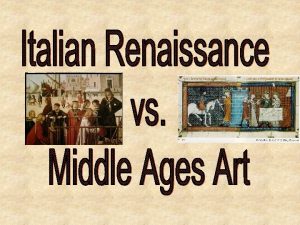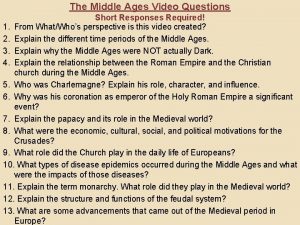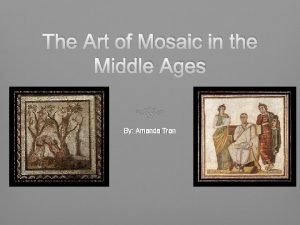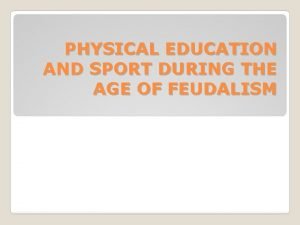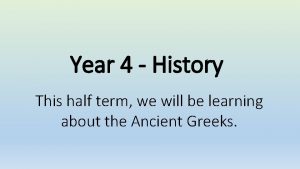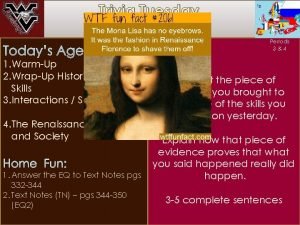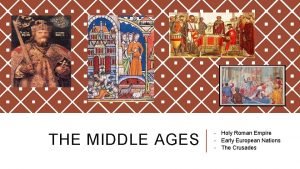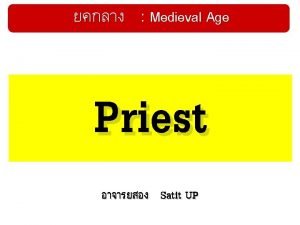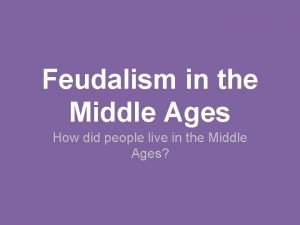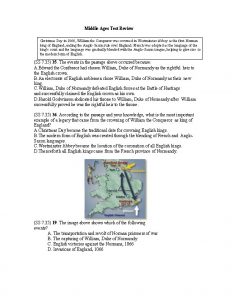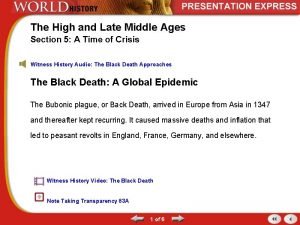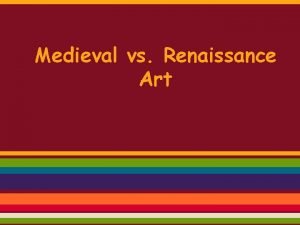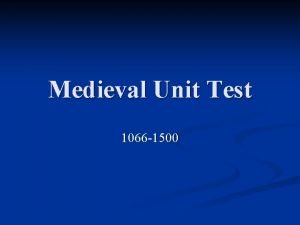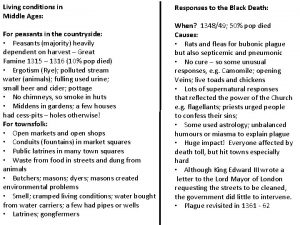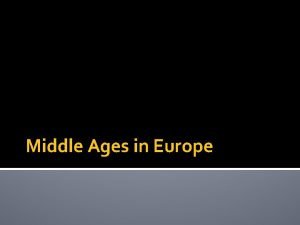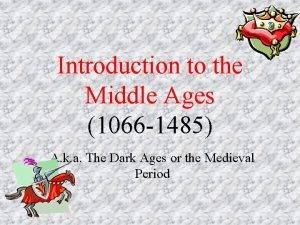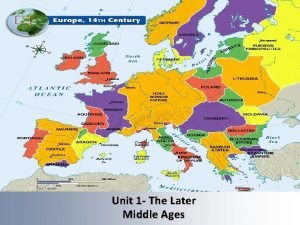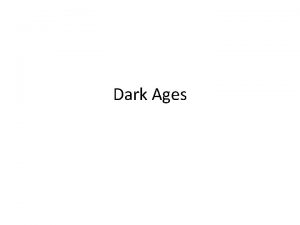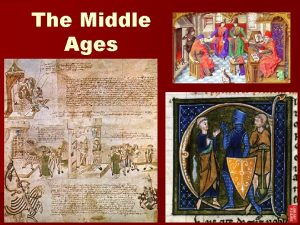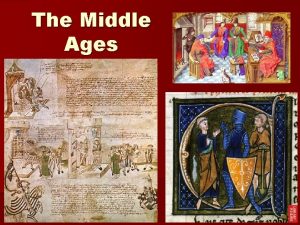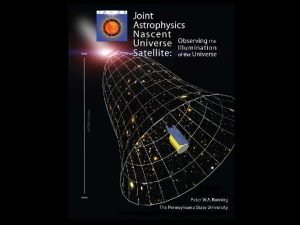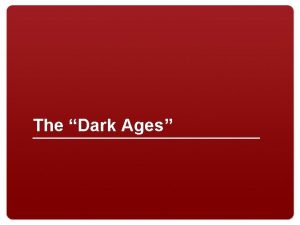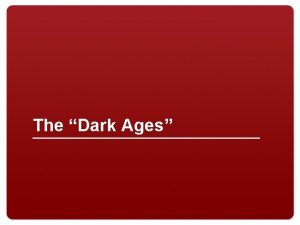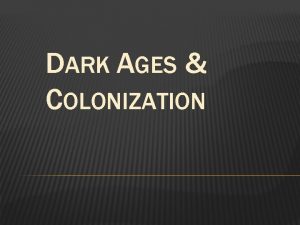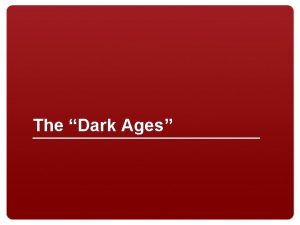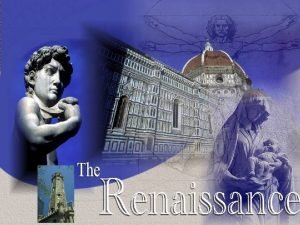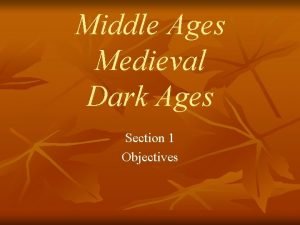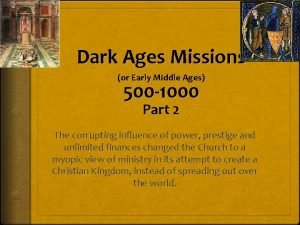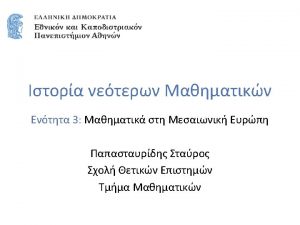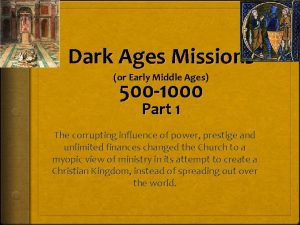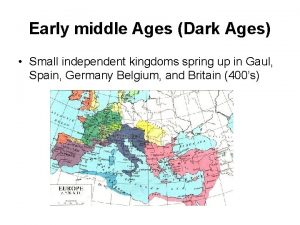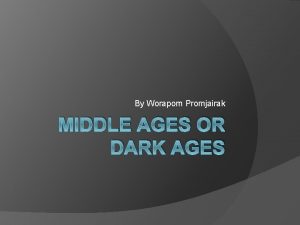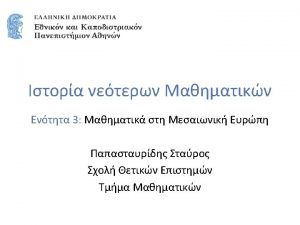The Middle Ages The Dark Ages The Kingdom





























- Slides: 29

The Middle Ages The Dark Ages

The Kingdom of the Franks Charlemagne (742 -814 AD) In 771, Charlemagne became king of the Franks. He embarked on a mission to unite all Germanic peoples into one kingdom, and convert his subjects to Christianity. A skilled military strategist, he spent much of his reign engaged in warfare in order to accomplish his goals. In 800, Pope Leo III (750 -816) crowned Charlemagne emperor of the Romans. Considered the “father of Europe”. When he died in 814, Charlemagne’s empire encompassed much of Western Europe, and he had also ensured the survival of Christianity in the West.

The Kingdom of the Franks Charlemagne (742 -814 AD) Most importantly…

The Kingdom of the Franks Charlemagne (742 -814 AD) Most importantly… He encouraged the Carolingian Renaissance, a cultural and intellectual revival in Europe.

The Kingdom of the Franks Charlemagne (742 -814 AD) Most importantly… He encouraged the Carolingian Renaissance, a cultural and intellectual revival in Europe. How did he do this? And what did he do exactly?

The Roman (Catholic) Church Monastic life Influence on the Carolingian Renaissance Growth in power and authority (potestas & auctoritas)

The Roman (Catholic) Church Monastic life μοναχός (monachos) = “alone“ μόνος = one In the beginning, in Egypt, Christians felt called to a more reclusive or eremitic form of monastic living (in the spirit of the "Desert Theology" for the purpose of spiritual renewal and return to God). Saint Anthony the Great is cited by Athanasius as one of these early "Hermit monks".

The Roman (Catholic) Church It began to develop early in the history of the Church, but is not mandated as an institution in the scriptures. It has come to be regulated by religious rules (e. g. the Rule of St Basil, the Rule of St Benedict) The Christian monk embraces the monastic life as a vocation for God. His goal is to attain eternal life in his presence. The rules of monastic life are codified in the "counsels of perfection".

The Roman (Catholic) Church By the ninth century, however, the Benedictine had become the standard form of monastic life throughout the whole of Western Europe, excepting Scotland, Wales, and Ireland, where the Celtic observance still prevailed for another century or two. Largely through the work of Benedict of Aniane, it became the rule of choice for monasteries throughout the Carolingian empire. Although Benedictines do not take a vow of silence, hours of strict silence are set, and at other time silence is maintained as much as is practically possible.

The Roman (Catholic) Church They continued the tradition of community life with its common prayer, reading, and work. Some of the monasteries were founded as centers of evangelization of peoples; others carried on a program of education, art and architecture, and the making of manuscripts. But after the empire fell, they began a slow but steady decline in scholarship.

It's a hard-monk life – for us. The Simple and Solemn Vows Upon entering the monastery, all candidates took a vow of obedience. Their initial period, the postulancy, lasted for one month. After one month, the period of novitiate began, lasting one year. Following successful completion of the novitiate period, monks took their simple vows. After four years of practice and service, the solemn vows were taken, and the full member of the monastery remained a monk, and a member, for the duration of his life.

It's a hard-monk life – for us. The Simple and Solemn Vows While many different orders of monks arose during the Middle Ages, the Benedictine monks remained the most common. Final, or solemn, vows for monks could vary from one order to another, but they typically included the three solemn vows of the Benedictines: the vows of…

It's a hard-monk life – for us. The Simple and Solemn Vows While many different orders of monks arose during the Middle Ages, the Benedictine monks remained the most common. Final, or solemn, vows for monks could vary from one order to another, but they typically included the three solemn vows of the Benedictines: the vows of… obedience, chastity, and poverty. Why?

It's a hard-monk life – for us. The Simple and Solemn Vows The vow of obedience ensured Middle Ages monks would obey any directives given to them, abide by the rules of the monastery, and perform the chores and duty necessary to the continued running of the monastery. The vow of poverty precluded monks from the possibility of owning land or property of any kind. The vow of chastity was strict, and was designed to prevent monks from giving in to what were considered base urges of lust.

It's a hard-monk life – for us. Religious faith was a critical component in the daily life of everyone. Daily prayer rituals were customary, often several times a day, particularly at mealtimes. Religion and spiritual faith held great sway over most individuals of the time, who sought to live their lives in service of God.

It's a hard-monk life – for us. The life of a monk was not a simple one either, but life in the monastery afforded individuals so inclined an opportunity to escape the tedium or drudgery of work on a manor or estate and avoid unnecessary military conflicts. BIG DEAL!!!!!! Monkhood was available to members of every class who chose to pursue it.

It's a hard-monk life – for us. Daily Routines A monastery was a wholly self-sufficient community, meaning monks had no reason to ever leave its boundaries once they had taken their vows. Monks, therefore, fulfilled a number of different roles based upon their own training, interests, and skills. Some monks specialized in medical care, others in education, still others in arts or finance.

It's a hard-monk life – for us. Daily Routines ora et labora

It's a hard-monk life – for us. All work being performed ceased immediately when prayer times arrived. Middle Ages monks returned to their prior activities following prayer sessions. All daily tasks, work, study, and meals needed to be fitted in around the designated prayer times, creating a regimented and disciplined lifestyle for all monks in the monastery.

It's a hard-monk life – for us. Middle Ages monks were expected to have no need of leaving the monastery at any time for any reason. The monastery was designed to meet any needs the monks who resided there could have. Monasteries provided education, spiritual sustenance, food, medical care, barber services, and any material possessions necessary for survival.

It's a hard-monk life – for us. Monks spent much of their time engaged in the daily prayer rituals and private meditation, Bible study, and prayer. However, the bulk of their days revolved around the manual work assigned to them in order to keep the monastery running smoothly. This could include harvesting crops, cleaning, creating garments, providing educational and medical services, and cooking and preparing food for the order.

So what happened? All work being performed ceased immediately when prayer times arrived. Middle Ages monks returned to their prior activities following prayer sessions. All daily tasks, work, study, and meals needed to be fitted in around the designated prayer times, creating a regimented and disciplined lifestyle for all monks in the monastery. As with all things, with the fall of the empire, monastic learning and life deteriorated as well.

The Roman (Catholic) Church Influence on the Carolingian Renaissance Where does it start?

The Roman (Catholic) Church Influence on the Carolingian Renaissance Where does it start? St Patrick (390 -461 AD) probably mostly true. Born among the Christians of west Briton. Captured by pirates. Sold into slavery in Ireland. Sounds like the Princess Bride. Escapes to Gaul and studies at the Monasteries.

The Roman (Catholic) Church St Patrick (390 -461 AD) probably mostly true. Goes back to Ireland spreads Christianity (Catholicism). Sets up and organizes monasteries Grow and develop a writing style with rules.

The Roman (Catholic) Church St Patrick (390 -461 AD) probably mostly true. Goes back to Ireland spreads Christianity (Catholicism). Sets up and organizes monasteries Grow and develop a writing style with rules.

Charlemagne & the Church As part of his reforms, demands educated monks and priests. Requires the promotion of reading and writing. Encourages the copying of manuscripts.

Charlemagne & the Church

The Roman (Catholic) Church Growth in power and authority (potestas & auctoritas) Next week.
 Dark ages vs middle ages
Dark ages vs middle ages Dark ages def
Dark ages def Old kingdom middle kingdom new kingdom
Old kingdom middle kingdom new kingdom Old kingdom middle kingdom new kingdom
Old kingdom middle kingdom new kingdom Old kingdom middle kingdom new kingdom
Old kingdom middle kingdom new kingdom Old kingdom middle kingdom new kingdom
Old kingdom middle kingdom new kingdom Dark ages vs renaissance
Dark ages vs renaissance Dark ages video questions
Dark ages video questions Medieval period mosaic
Medieval period mosaic Physical education during the age of feudalism
Physical education during the age of feudalism Greek dark ages timeline
Greek dark ages timeline Dark ages def
Dark ages def Grabalaptop
Grabalaptop Renaissance vs middle ages
Renaissance vs middle ages Dark ages holy roman empire
Dark ages holy roman empire Dark matter and dark energy presentation
Dark matter and dark energy presentation In a dark dark town
In a dark dark town Catholic church ranks
Catholic church ranks Feudal system in the middle ages
Feudal system in the middle ages Middle ages test review
Middle ages test review The high and late middle ages section 5 quiz
The high and late middle ages section 5 quiz Renaissance art vs medieval art
Renaissance art vs medieval art How is this
How is this Sacred music in the middle ages
Sacred music in the middle ages The middle ages 1066 to 1485 unit test
The middle ages 1066 to 1485 unit test Middle ages def
Middle ages def Living conditions in the middle ages
Living conditions in the middle ages Middle ages def
Middle ages def The middle ages 1066 to 1485 unit test closed book
The middle ages 1066 to 1485 unit test closed book European middle ages map
European middle ages map






